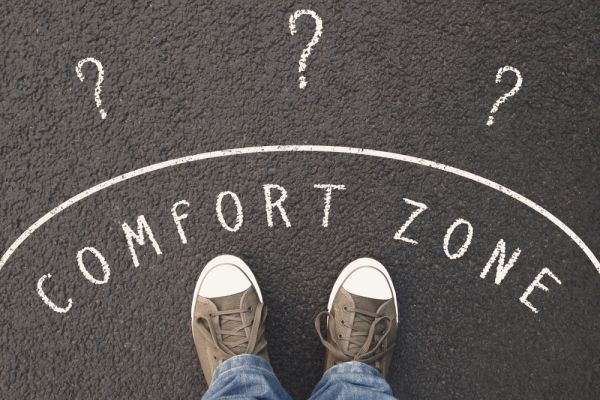The Causes of Anxiety
The true cause of anxiety is being a human being, gifted with the capacity to imagine a future. As a mental state of apprehension about what might, or might not, lie ahead, anxiety reflects uncertainty about future circumstances, whether regarding one’s own health, job, or love life, or climate change or a downturn in the economy. It can be triggered by events in the real world—an upcoming doctor’s visit, relationship conflict, a rent increase—or generated wholly internally, through thoughts of real or imagined threats (not knowing what to say when the boss calls on you in a meeting).
Occasional bouts of anxiety are entirely normal and one of the unavoidable costs of being alive; anxiety alerts us to danger, compels our attention, and urges us to make necessary preparations to protect ourselves. But sometimes worries intensify or persist, endlessly caroming through the brain without engaging problem-solving mechanisms, or overwhelming them, and impairing the ability to function. Many factors can contribute to prolonged rumination—worry, the cognitive component of anxiety— over uncertain outcomes.
On This Page
- What are the most common causes of anxiety?
- Can stress bring on anxiety?
- Why are rates of anxiety increasing?
- What is the difference between fear and anxiety?
- Is anxiety ever good?
- Who is prone to anxiety?
- Do genes cause anxiety?
- Can uncertainty cause anxiety?
- Does personality play a role in anxiety?
- What biological factors influence anxiety?
- Are there risk factors for anxiety?
- What happens in the brain with anxiety?
- Why does anxiety so often occur with depression?
Anxiety is a response to uncertainty and danger, and the trigger can be almost anything, or nothing in particular, just a generalized, vague sense of dread or misfortune. High on the list of anxiety-generating situations is having to give a talk or presentation or being called on in class, where people risk loss of social standing by being judged negatively.
People can feel anxious because their neural circuitry has become so sensitized it perceives threat where it doesn’t exist. Too, there are substances—caffeine is one—and medications that stimulate the same physical sensations as anxiety. People differ in their susceptibility to anxiety, as a result of their biological makeup, their parental inheritance, their own life history, personality factors, and the coping skills they acquire or cultivate.
Anxiety and stress are intimately related; anxiety is a reaction to stress. Anxiety is the name we give to the internal sensations of warning generated by the body’s reaction to a mental or physical threat. The sensations are set in motion by the stress response (or fight-or-flight) system, whose job is to alert us to and protect us from danger. Without waiting for us to make a conscious assessment of any danger, it swiftly sends out chemical warning signals, such as cortisol and adrenaline, to various organs. The physical discomfort of anxiety is like a bodyguard; its job is to protect us by jolting us into action. But it can persist and, by altering the function of neural circuits in the brain, overwhelm the ability to exert rational control.
Anxiety in its several forms, including phobias and social anxiety, is the most common mental health disorder in the U.S. Population-based surveys indicate that about a third of adults in the U.S. will grapple with disabling anxiety at some point.
High as the number is, there is some—and sometimes conflicting—evidence that the prevalence of anxiety (and depression as well) is increasing, especially among the young. Several factors are thought to be responsible for a rise in prevalence. In general, as the middle class erodes, there is growing economic uncertainty for much of the population. The high cost of health care also creates a burden of chronic worry about getting sick. In addition, a lack of coping skills, emotion regulation skills notably among them, is said to be making younger people vulnerable to a number of mental health disorders, particularly anxiety and depression.
Social media are singled out for their especially pernicious effect on young teens, because they introduce a means of constant social comparison and, through it, self-doubt—and that self-doubt drives further social media use, with compounding negative effects. In addition, dating and mating practices are far less structured than in past eras, and digital forms of communication create so much ambiguity that young people are often clueless about where they stand in romantic relationships. Ambiguity typically breeds anxiety.
Anxiety differs from fear in several important ways. Fear is a response to present danger; it is usually highly focused, attached to a very specific thing or circumstance, and meant to mobilize fast action. Anxiety doesn’t require an external stimulus; it is a response to real or imagined future threat, and it is typically more diffuse, setting in motion the need for constant vigilance in anticipation of some calamity. Fear is contagious, marked by characteristic features—widened pupils, pale skin —that signal others to be afraid. Anxiety is highly subjective. While anxiety shares some of the physiological signs of fear—heightened awareness and fast heart rate, similarly set off by the hormones of the stress response—it carries a heavy cognitive load of worry, a form of rumination about what might possibly go wrong in the future.
Anxiety is the reason your ancestors survived, enabling you to be reading these words now. Anxiety reflects the sensations that are triggered in body and brain in response to perceiving a threat; they’re intended as an alarm, to jolt you into paying attention and taking appropriate action to head off possible danger. In short, anxiety protects you. But the system is built to err on the side of caution, which is why we feel anxious even in the absence of a real threat. The sensitivity of the alarm can be reset by traumatic experience so that it is always on. Further, the threats can be wholly invented by your own imagination—thoughts of ways any situation could possibly go wrong. Neither flaw in the system diminishes the value of anxiety—to keep you alive.
To a large degree, people who are prone to clinical depression are also vulnerable to clinical anxiety. The conditions have many features in common. Chief among them is a history of adverse childhood experience, such as abuse or neglect. The reason is that maltreatment can indelibly alter the stress system so that it is hypersensitive to danger and reacts with an outpouring of alarm signals that overwhelm the capacity for emotion processing. Scoring high on the personality trait of neuroticism also inclines an individual to anxiety. Neuroticism reflects a tendency to respond to stressful experiences most readily and intensely with negative emotions and to perceive threats where they do not exist. In addition, people who lack the skills of emotion regulation are vulnerable to anxiety; they can be easily overwhelmed by situations that create uncertainty or stir any negative feelings.
No one has ever identified an “anxiety gene,” and it is unlikely that one will ever emerge; anxiety proves to be a complex condition that arises through many pathways. Some studies estimate that the heritability of generalized anxiety is no more than 30 percent. As with the transmission of depression-prone styles of thinking, families lastingly shape their children by many means. For example, the adults may display and, by the power of repeated example, silently pass on to their children skills for coping with the kinds of emotionally disruptive experiences that can trigger anxiety—or they may become disorganized and unable to function by such experiences. Nevertheless, studies indicate that genes lay a foundation for anxiety primarily by contributing to the personality trait of neuroticism, characterized by volatility of the negative emotion system. It is observable in the readiness to perceive the negative aspects of challenging situations and to react to them with negative emotions.
Uncertainty doesn’t cause anxiety but it creates breeding grounds for anxiety, and the rise of uncertainty in much of public (jobs, national security, pandemics) and private (relationships) life may be one reason why anxiety has become the most prevalent mental health condition today. Worry, the cognitive component of anxiety, is activated by the mere possibility of a bad outcome—and for many modern concerns, possibility can almost never be ruled out entirely. But of course, possibility does not equal probability. Anxiety with its payload of worry can be seen as an attempt to avoid uncertainty—to dispel the discomfort it creates. The better approach, say experts, is to learn to tolerate some uncertainty and recognize that most of life is not black or white but shades of gray.
There is a type of personality consistently associated with anxiety—those who exhibit the trait of neuroticism. One of the so-called Big Five personality traits, it describes a broad tendency to respond to experience with negative emotions and to be roiled by them. In study after study, neuroticism predicts susceptibility to both anxiety and depression and, to a lesser degree, all other mental disorders. Scientists believe that neuroticism reflects emotional reactivity that is especially attuned to threat. Some facets of neuroticism —perfectionism stands out—are virtually free tickets to anxiety. Perfectionists may seem like they’re on a path to success but in fact they are driven by a desire to avoid failure; as a result, much of their mental life is devoted to worrying about mistakes they could possibly make and imagining dire consequences of those mistakes..
The state of a person’s health, past or present, plays a large role in triggering anxiety. Those with chronic conditions such as diabetes or heart disease are at risk of constant worry about getting sick or sudden death. In fact, having a heart attack is known to raise the risk of health anxiety by 20 to 30 percent. People with breathing problems such as asthma or who have severe allergies to common substances may live with chronic worry about exposure to triggering substances. Some people are highly sensitive to internal body sensations—interoception—and may devote so much mental energy to monitoring, say, their heartbeats that every variation becomes a source of doubt and concern. A large number of people—in some estimates, as many as 20 percent of the population—are said to be highly sensitive; having a low threshold of nervous system arousal, they overrespond to both internal and external stimuli and can be easily overwhelmed emotionally. Their reactivity is linked to the personality trait of neuroticism, one of the strongest risk factors for anxiety.
There are multiple factors that create vulnerability to anxiety under stressful circumstances. On a purely psychological level is the ability to manage negative emotions. People lacking emotion regulation skills are at heightened risk of both anxiety and depression. Having a history of adverse life experiences during childhood, such as intense maltreatment or bouts of serious illness, also predisposes people to anxiety. It doesn’t change the makeup of genes but it can permanently alter their level of activity so that that the brain is constantly on the lookout for and perceiving potential threats. Perhaps the strongest risk factor for anxiety is having the personality trait of neuroticism. It denotes the degree to which the negative affect system is readily activated. People high in trait neuroticism are dispositionally inclined to find experiences distressing and to worry.
Neuroimaging studies reliably show changes in brain function among those who experience chronic anxiety, and they involve dysfunction of connectivity among areas of the brain that work together to orchestrate emotional response. Under normal circumstances the brain region known as the amygdala flags threats and, in an act of protection, sends out a signal to many parts of the brain. The stress response system kicks in immediately, preparing the body for action. On a slower track, signals travel to the prefrontal cortex, the so-called thinking brain, where the threat can be evaluated and, if needed, action planned to ameliorate any potential danger. But in anxiety, often because the amygdala has been sensitized by early adverse experience, it overresponds, overwhelming the capacity of the PFC to rationally assess and manage any threat, however remote or hypothetical.
Researchers have recently identified a tiny brain region known as the BNST, the bed nucleus of the stria terminalis, as a major node in brain circuits of anxiety. About the size of a small sunflower seed, it is considered an extension of the amygdala. Its primary function is to monitor the environment for vague, psychologically distant, or unpredictable threats—say, imagining that you’ll stumble badly and embarrass yourself when you give that upcoming talk. And when activated, it sends out alarms prompting alertness and hypervigilance to potential danger—the hallmarks of anxiety.
Depression and anxiety share much in common—they both derive from overresponsiveness of the negative affect system, the distinguishing feature of the personality trait of neuroticism. People with the trait of neuroticism tend to react to experience most readily and most strongly with negative emotions, such as irritability, anger, and sadness. Many of the same brain regions malfunction in both conditions, most notably the amygdala (overactivated) and prefrontal cortex (underactivated). But there are important differences. Anxiety is an alarm intended to energize people to avoid possible future danger they sense; depression shuts people down when they feel overwhelmed, disinclining them to ongoing activity and focusing their attention on losses and other negative experiences in the past. Stress can trigger both responses. And anxiety itself can lead to depression. In fact, nearly 70 percent of people who suffer from depression also have anxiety, and 50 percent of those with anxiety have clinical depression.














